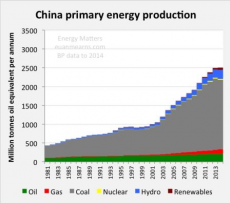
Email: emanuelealbertocirello.98@gmail.com
Total Article : 76
About Me:I am a Year 13 student which aspires to be an architect. I am interested in anything I don't yet know, and I mostly write about art, politics , Italian culture and inspirational people, although I will try to write for as many categories possible, just to test myself and get to know more things.

It is understandable that despite the wealth of the country in energy resources, these will not meet the rising demand of energy.
China’s coal reserves will continue to provide most of its energy well into the foreseeable future. The nation’s oil and natural gas supply, however, will be unable to satisfy demand.
China’s oil supply situation is precarious. Its oil reserves are supposedly of 24 billion barrels (bb), which constitute just 2.3% of the world total for a country with 22% of the world’s population. These estimates are however highly speculative, and they may be artificially high in order to attract foreign investments, while those offered by oil companies may be artificially low to strengthen their trading potential. Scattered evidence suggests an industry consensus of around 68 bb for total proven and potential reserves. The oil production has currently peaked, but exploration has begun at full speed. The government is exploring large oil deposits in the Tarim Basin, which may not be accessible due to their remoteness, and deep water exploration in China is affected by territorial conflict with nearby nations such as Vietnam. These issues have forced China to import most of its oil.
China’s natural gas supply is more limited than oil. These reserves are largely undeveloped as a result of policies based on the view that natural gas exploration and production are subordinate to oil exploration and production as well as a lack of investment, infrastructure, and technology. It has proven costly and complex to build pipelines from gas fields to consumers in western China, and the transport of liquefied gas for transport ships is in short supply and could cause harm to the environment through spillages etc.
China us also the world’s biggest producer and consumer of coal. 70% of its coal is used for electricity production, and future projections show that this dependency is only destined to rise at this pace, nearly doubling in 2030. Its high demand means that the pressure on supply is even greater, with an average of three new-coal fired power station per week.
Hydro-electricity currently accounts for 16% of the country’s energy production. The Three Gorges Dam is set to be the world largest dam, and will generate 25 gigawatts of electricity. But however these large scale dam building schemes are causing major issues, with some arguing that they increase earthquake risks in some regions, as observed in 2008 earthquake in Sichuan province.
China’s rapid economic growth is largely responsible for its rising energy demand, and projections assume that fairly rapid growth will continue. As the economy will keep developing, the demand will keep increasing.
Most of China’s energy is in fact used up by industries, with 71%. By 2020, the energy demand projections regarding energy demand show that it will double, and by 2030 the total million tonnes of oil equivalent will be 6000mln, from a 2500mln in 2010. As China’s economy continues to grow, its demand for all sources of energy, notably oil and natural gas, will increase.

Oil demand is projected to grow at an average annual rate of 3.8 percent during the period 1996–2020, increasing consumption from 3.5 million barrels per day (mb/d) to 8.8 mb/d. China’s demand for natural gas is growing more rapidly than that for other sources of energy, with the result that natural gas is expected to grow from 2 percent of China’s energy consumption in 1996 to 11 percent in 2020. The demand for nuclear energy and renewable energy is projected to increase, but these sources will remain a tiny fraction of primary energy consumption because of financial, technological, and ecological limitations.
The growth of capital investments has therefore made China an economic superpower, but not much of an energy superpower.
Economic growth will also mean that the living standard of the Chinese population will increase steadily. It is predicted that car ownership will jump from 16 cars per 1000 people in 2002 to 267 cars per 1000 people by 2030. This will mean that 25% of the world’s car demand will come from China only. Currently, 1000 new cars arrive On Beijing’s street every day, meaning that the pressure on oil reserves is skyrocketing.
8% of the world’s oil demand comes from China, but it also accounts for the 33% of the current growth in demand. This made China’s dependency on imported oil reach 60% in 2010, and this is only rising even more. China used to be self-sufficient on oil only until 1992, and since then the net imports have just kept on growing. The production of oil has been fairly regular but the rise of demand and the gap between consumption and production has made China energy insecure.
Ironically, the production of energy itself requires China to use most of its energy supplies. For instance the biggest consumer of coal reserves is the electric power industries, and with increasing population, economy and living standards, this is only destined to increase.
Image credits: http://suddendebt.blogspot.co.uk/2010/12/energy-tale-of-four-nations.html
http://oilprice.com/Energy/Crude-Oil/Chinas-Energy-Demand-May-Not-Increase-Until-2017.html

0 Comment:
Be the first one to comment on this article.